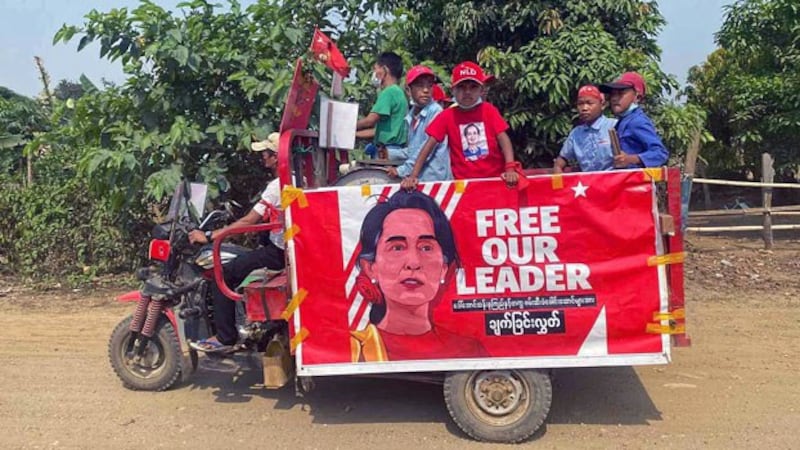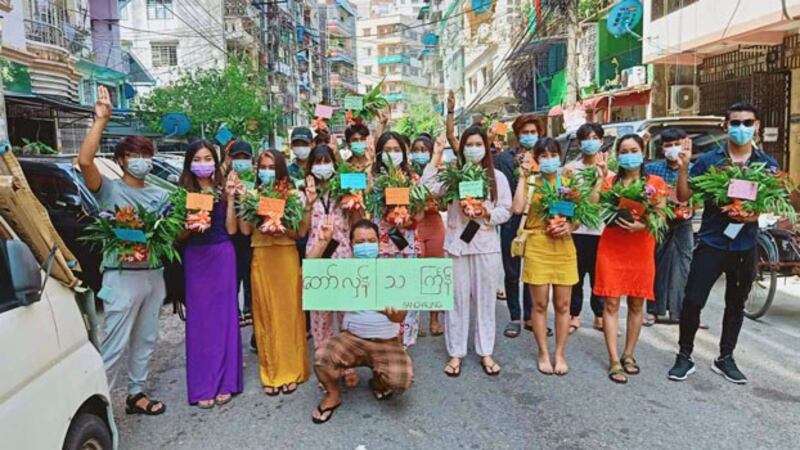With little to celebrate as they kicked off the Burmese New Year on Tuesday, people across Myanmar staged holiday-themed protests to defy the military junta in what an activist called “a funeral wake for the whole country,” while the U.N. rights chief said she feared the nation faces a fate similar to war-shattered Syria.
Opponents of the generals who overthrew the country’s elected government on Feb. 1 scrapped water-related blessings of the Buddhist Thingyan Water Festival for protest messages, strikes, and memorials to victims of the army regime that has turned rifle grenades and battlefield weapons on unarmed civilians.
“Now is like a funeral wake for the whole country because of the atrocities of the military junta,” a young man from Yangon who called himself Harry. “More than 700 people have died because of their brutality. This is not a time for celebrations.”
The holiday — which runs from April 13 to April 16 and versions of which are observed in Cambodia, Laos, Thailand, and other Asian countries — is normally marked by singing, dancing, feasting, and mass soaking in joyful water fights.
“We’re not celebrating Thingyan as we traditionally do. We’re holding various campaigns to defy them,” Harry said, referring to the army regime.
Already dampened last year by crowd restrictions to combat the coronavirus pandemic, Thingyan this year saw at least four people killed and dozens of others arrested in nationwide crackdowns, while in Kachin state near the border with China military air strikes drove more than 1,000 villagers from their homes.
Fighting between the Kachin Independence Army (KIA) and the military intensified on April 10. Nine civilians, including a Buddhist monk, were killed by heavy artillery during nighttime air raids on April 11 during an attempt by Myanmar forces to recapture strategic hills, according to a Kachin political leader.
“War is nothing new to people in Kachin state. It has been going on for a lifetime,” said Dwe Bu, vice chairwoman of the Kachin State People’s Party. Kachin state has been at war on and off since 1948, when the then Burma became independent from Britain.
“But the recent fighting has been intense, and the air strikes have become even more troubling for the people. They have had to flee their homes,” she told RFA.

Kachin military analysts say there have been about 30 clashes across the state in the past 60 days, with more than 120,000 civilians displaced by previous fighting unable to return home.
Ten Myanmar military soldiers were killed and several others were wounded in overnight fighting with KIA fighters in Mogok in Mandalay region, the Democratic Voice of Burma (DVB) reported Tuesday.
KIA spokesman Colonel Naw Bu told RFA that he had not yet received information about the Mogok clash.
A resident of Kachin’s Sihat village, who did not want to be named for security reasons, said her community was nearly deserted.
“They no longer dare to stay in the village,” she said about her neighbors. “Some have moved to villages where they have relatives, and some are hiding in the woods using logs and branches to make makeshift bomb shelters. Almost everybody has left our village since yesterday.”
Other villagers have fled to larger towns or to monastery compounds, local residents said.
“Since the beginning of the fighting, people have been fleeing to other villages, and then when the fighting got closer in the evening, they had to flee into the jungle,” said Naing Lin of Nong Kone village.
“People are living in fear. In this situation, no one can trust anyone,” he added.
At least five soldiers were injured Tuesday morning when a landmine exploded while a military convoy was patrolling the banks of the Uru River in Kachin’s Hpakant jade mining region, a key source of funds for the KIA, residents said.
When the mine exploded just in front of the convoy, two of the five soldiers who were sent to stop protests immediately fell to the ground, appearing to have been seriously injured, one witness said.
“Two explosions were heard,” he said. “Some shrapnel even hit nearby houses. The ground shook,” the witness said. It was unclear if the landmines were planted by the KIA or another ethnic armed group.
RFA could not reach junta spokesman Maj. Gen Zaw Min Tun for comment on the Kachin fighting.

More killings in ethnic lands
Violence rang out in other parts of Myanmar on Tuesday, with soldiers shooting dead an ethnic Gurkha couple who were delivering milk by motorbike in the town of Tamu in the northwestern region of Sagaing, near the border with India, a day after a seven-year-old was gunned down, witnesses told RFA.
The killing of the couple, members of an estimated 1 million Nepali-speaking descendants of Gurkha soldiers who served during British rule over what was then called Burma, was the latest of more than 20 people killed in the town, which is home to ethnic Naga rebels and awash with weapons, many home-made.
Naga forces led by the Kukai National Organization and its armed wing, the Kukai National Army — an insurgent group active in Northeast India and northwest Myanmar — attacked junta forces, killing 18 troops in response to a brutal crackdown on April 10, residents said.
U.N. High Commissioner for Human Rights Michelle Bachelet, called on Tuesday for immediate measures by the international community to push the military regime to stop the violence against the people, including air strikes targeting civilians in Kachin, Shan, and Kayin states.
“There are clear echoes of Syria in 2011. There too, we saw peaceful protests met with unnecessary and clearly disproportionate force,” she said. The Middle Eastern country is shattered and still fighting 10 years after the Arab Spring touched off protests.
“The military seems intent on intensifying its pitiless policy of violence against the people of Myanmar, using military-grade and indiscriminate weaponry,” Bachelet said.
“I fear the situation in Myanmar is heading towards a full-blown conflict,” she said in a statement.
Reported by RFA’s Myanmar Service. Translated by Khin Maung Nyane. Written in English by Roseanne Gerin.

